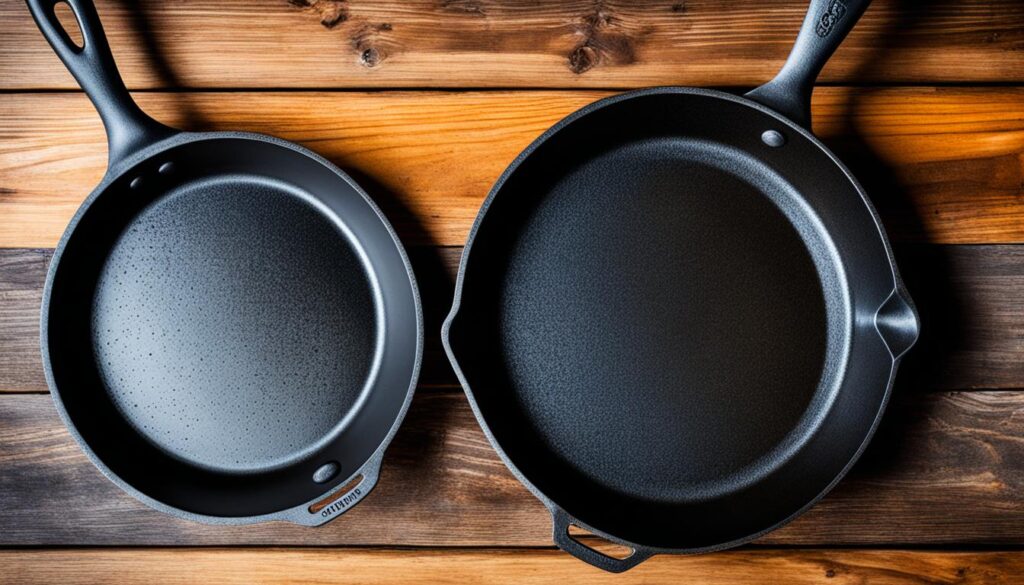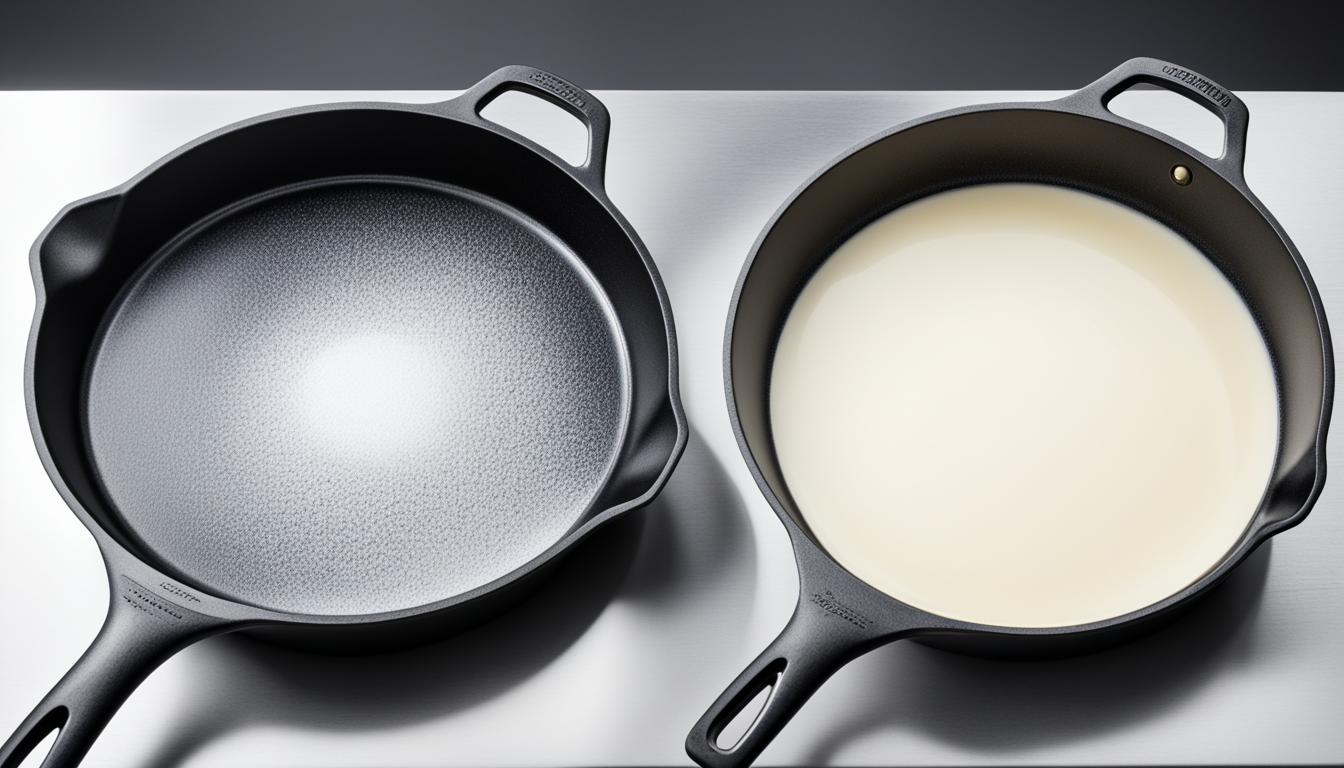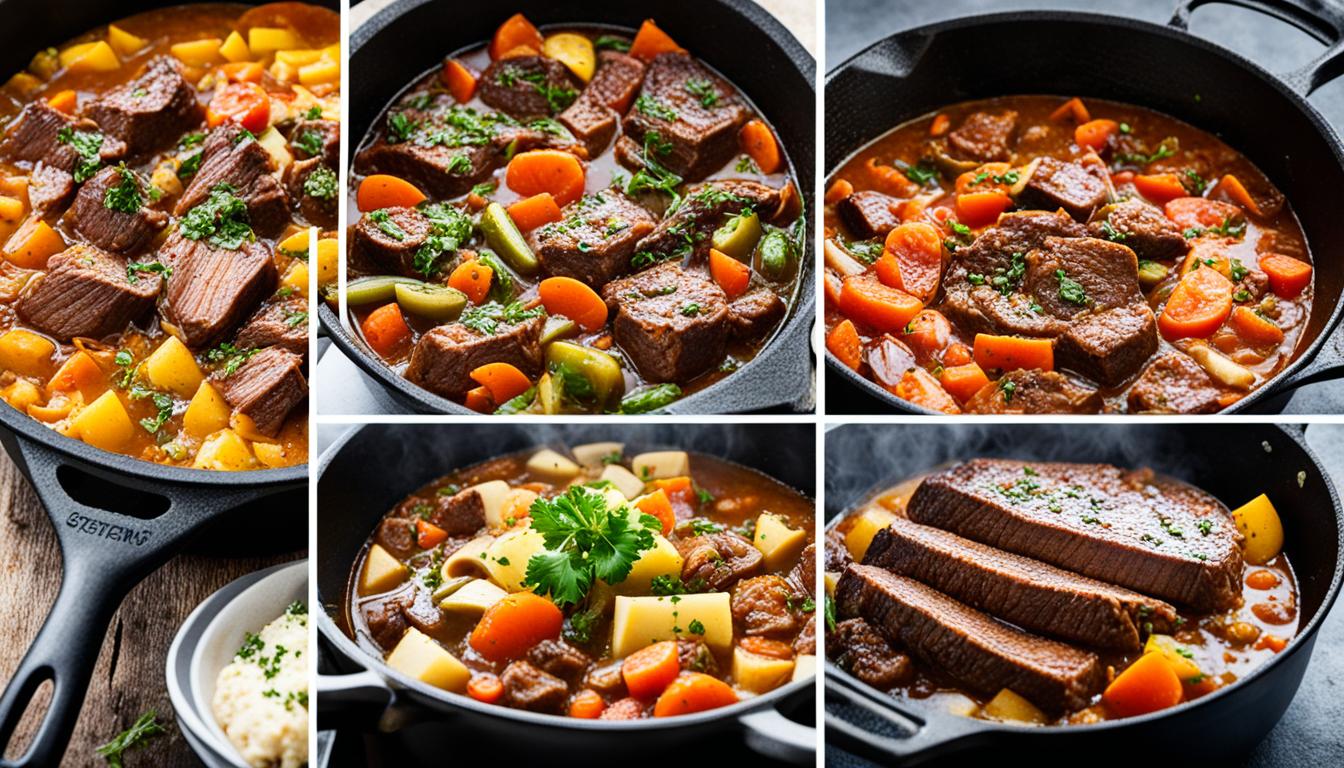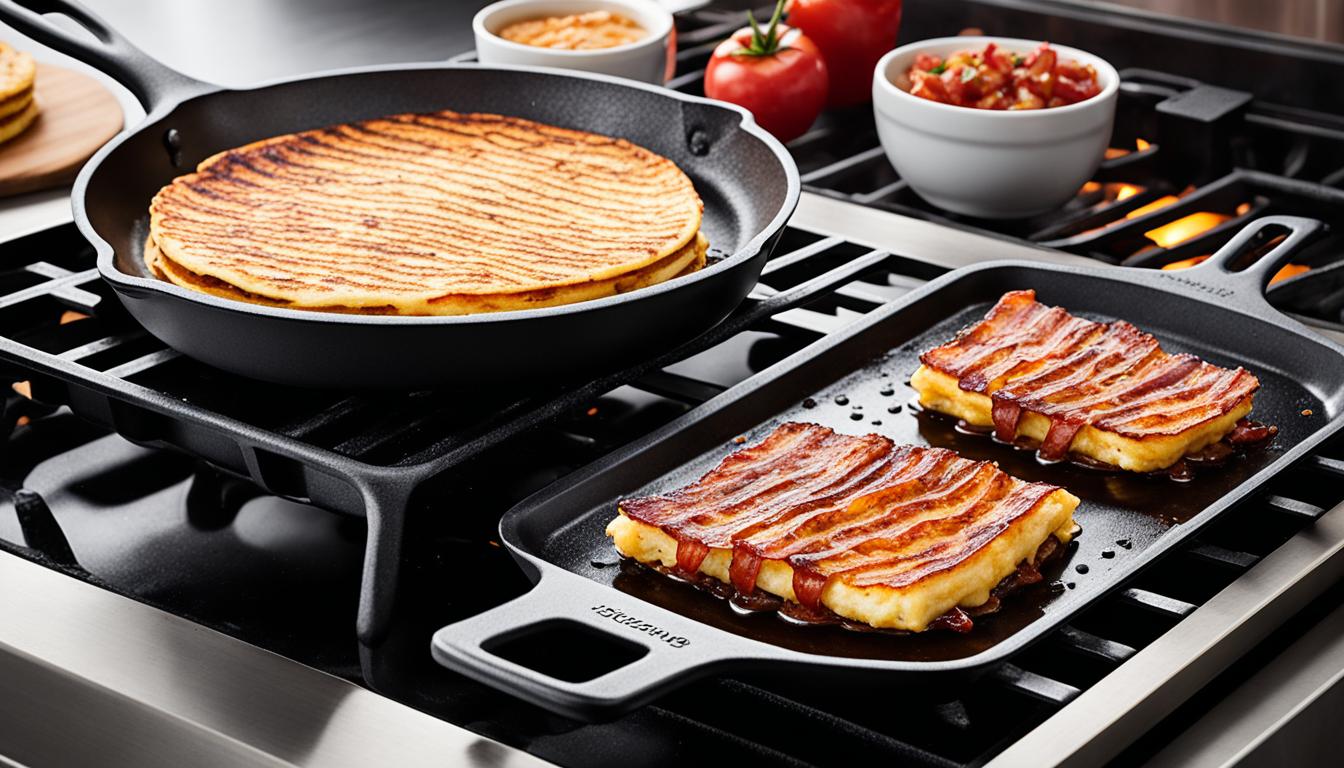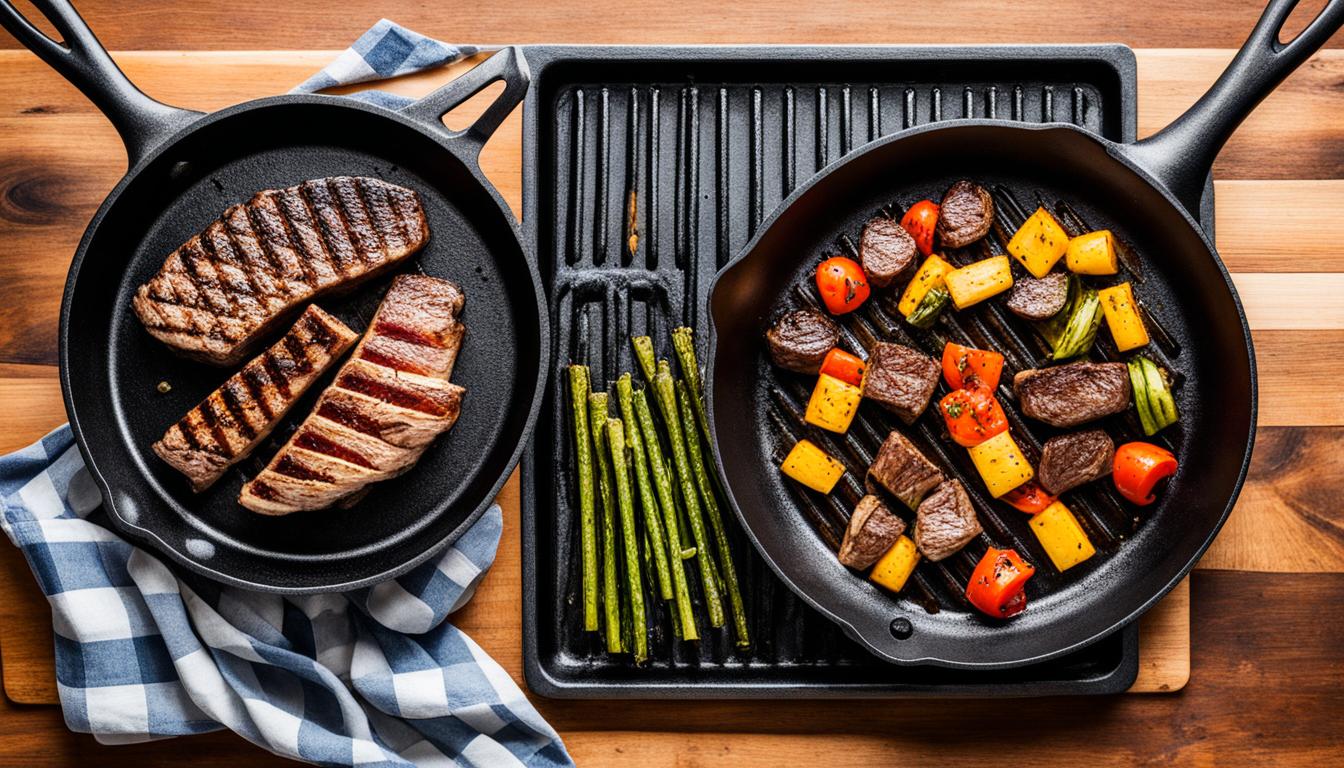Choosing between a cast iron and a carbon steel skillet can be tough. In the cookware aisle, you might feel swamped by the options. Each material has its own fans and benefits, further complicating your decision. Let’s compare these two kitchen staples to help you choose wisely.
Cast iron skillets have stood the test of time in kitchens. They are known for their toughness and ability to hold heat well. Meanwhile, carbon steel pans are lighter and heat up fast. I’ve cooked with both at home, and I see the value of each in the kitchen.
Both skillets excel in various cooking tasks. Whether it’s searing steaks or baking cornbread, they are up to the challenge. However, there are small differences to consider that might make one better for you.
We will look at several key points to help you choose between the two. This includes heat distribution, how easy they are to care for, and more. By considering these aspects, you can find the best skillet for your kitchen.
Key Takeaways
- Cast iron retains heat longer, while carbon steel heats up faster
- Carbon steel pans are lighter and easier to maneuver
- Both require seasoning for non-stick properties
- Cast iron is more durable but needs extra care to prevent rust
- Carbon steel is more responsive to temperature changes
- Both are versatile for stovetop and oven use
- The choice depends on your cooking style and preferences
Table of Contents [show]
Understanding the Composition of Cast Iron and Carbon Steel
Cast iron and carbon steel are top choices for cookware. It’s important to know their makeup. They are both iron alloys, but they have different carbon levels and how they are made.
The Carbon Content Difference
The big difference is their carbon content:
- Cast Iron: Contains 2-3.5% carbon
- Carbon Steel: Contains less than 2% carbon
This carbon difference changes how they act. Cast iron is more brittle due to its higher carbon. Carbon steel, with less carbon, is smoother and thinner.
How Composition Affects Performance
The ingredients affect how well they cook:
- Heat Retention: Cast iron keeps heat well
- Heat Conductivity: Carbon steel warms up and cools quickly
- Weight: Cast iron is heavier
- Seasoning: Both need seasoning, but carbon steel gets a better non-stick
To try new cooking methods, check out electric skillets with removable pans.
Durability and Strength Comparison
Both are durable but in different ways:
- Cast Iron: Can last ages with care
- Carbon Steel: Harder, chips less, but can rust easier

Knowing these details helps you pick the best cookware. Cast iron keeps heat well; carbon steel is very responsive. They each bring something special to cooking.
Heat Conduction and Retention Properties
Knowing your pots and pans is big for cooking. Cast iron and carbon steel pans work very differently. Cast iron takes its time to heat up but holds that heat well. On the other hand, carbon steel warms up and cools down quickly. This means it’s easier to control the cooking temperature with carbon steel.
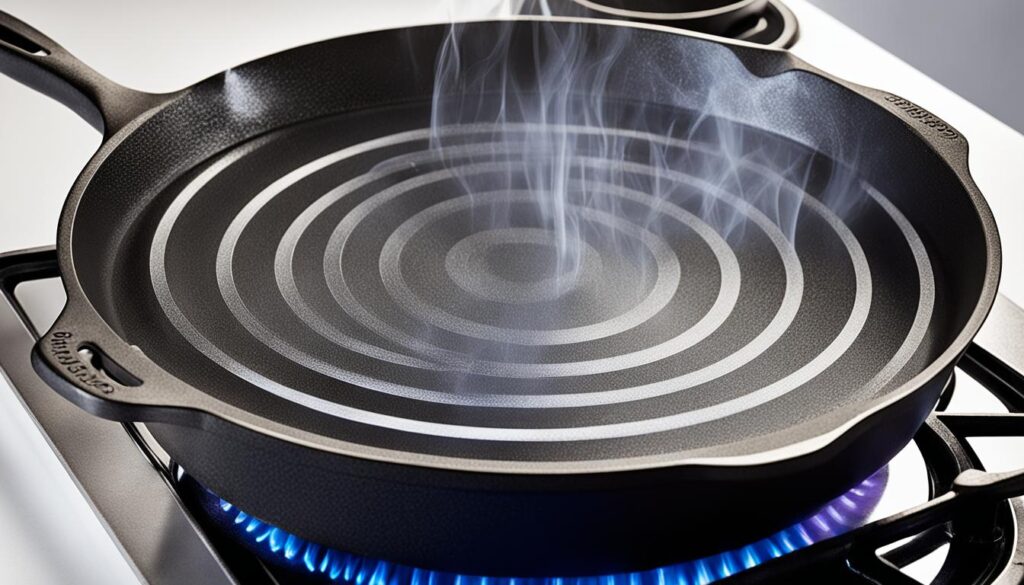
Cast iron is slow but steady in its heating. It holds on to the heat, making it great for searing meat or baking veggies. Carbon steel, however, is quick to change its temperature, allowing you to manage how hot your pan gets better. Let’s look closer:
- Cast Iron:
- Slow to heat up
- Retains heat exceptionally well
- May have some hot spots
- Carbon Steel:
- Heats up quickly
- Cools down faster
- More even heat distribution
Carbon steel is my go-to for tasks that need a light touch, like sautéing veggies or frying eggs. It reacts fast to changes in heat, which is important for cooking delicate foods without burning them.
To show you how these metals differ in performance, check out this table:
| Property | Cast Iron | Carbon Steel |
|---|---|---|
| Heat-up Time | Slow (5-7 minutes) | Fast (2-3 minutes) |
| Heat Retention | Excellent | Good |
| Temperature Control | Moderate | Excellent |
| Even Heat Distribution | Good | Excellent |
The different heat properties play a big role in how well you cook. For example, when you make a deep-dish pizza, cast iron makes the crust crispy due to its heat retention. But, for dishes on the stovetop that need exact heat management, carbon steel’s even distribution is key.
Seasoning Process: Cast Iron vs Carbon Steel
Seasoning is important to create a nonstick surface on cookware. Cast iron and carbon steel cookware need this special coat. But, the way we season them is a bit different.
Pre-seasoned vs DIY Seasoning
Some cast iron pans come pre-seasoned. This means they’re ready to use right away. Carbon steel pans, however, require seasoning by the user. This lets us have more say in how we season. But, it also means we need to put in a bit more work up front.
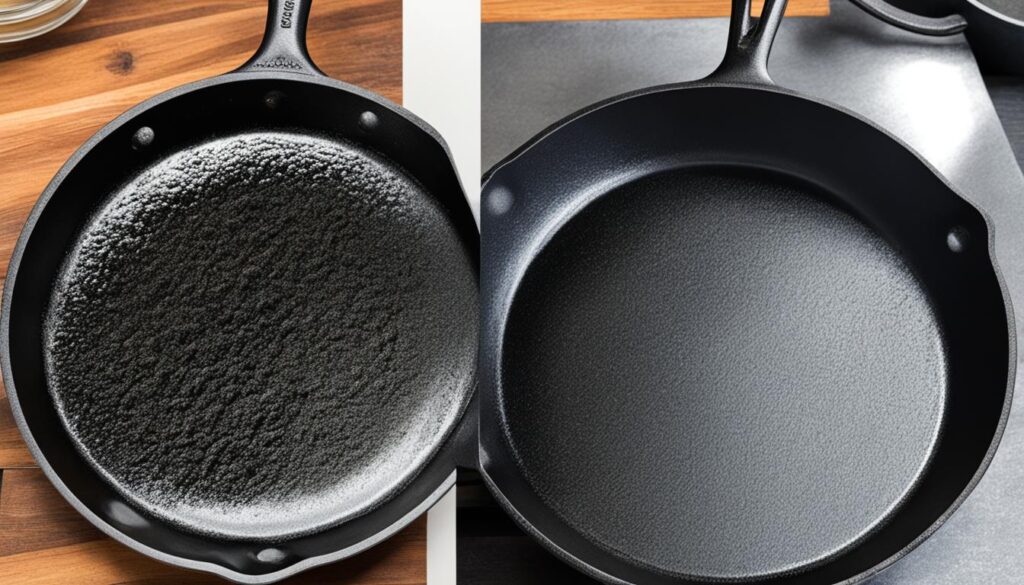
Maintaining the Seasoning Layer
To keep our pans in good shape, we should regularly oil them. After use, a thin coating of oil is a must. Also, we should steer clear of acidic foods like tomatoes. They can erode the seasoning layer.
- Clean the pan with hot water and a soft brush
- Dry thoroughly to prevent rust
- Apply a thin layer of oil after each use
- Heat the pan to lock in the seasoning
Impact on Non-stick Properties
A well-seasoned pan is the secret to non-stick cooking. A properly seasoned carbon steel pan can outdo cast iron. It shines when cooking eggs or fish. For instance, the Healthy Beef and Broccoli Stir Fry recipe works better in a seasoned pan.
It’s vital to regularly maintain both cast iron and carbon steel pans. With the right care, these pans become great for nonstick cooking. They prove to be valuable items in the kitchen.
Weight and Maneuverability Considerations
When you’re picking between a cast iron and a carbon steel pan, pay attention to the weight. The weight of a pan affects how you can handle it in the kitchen. This can really matter for your comfort.
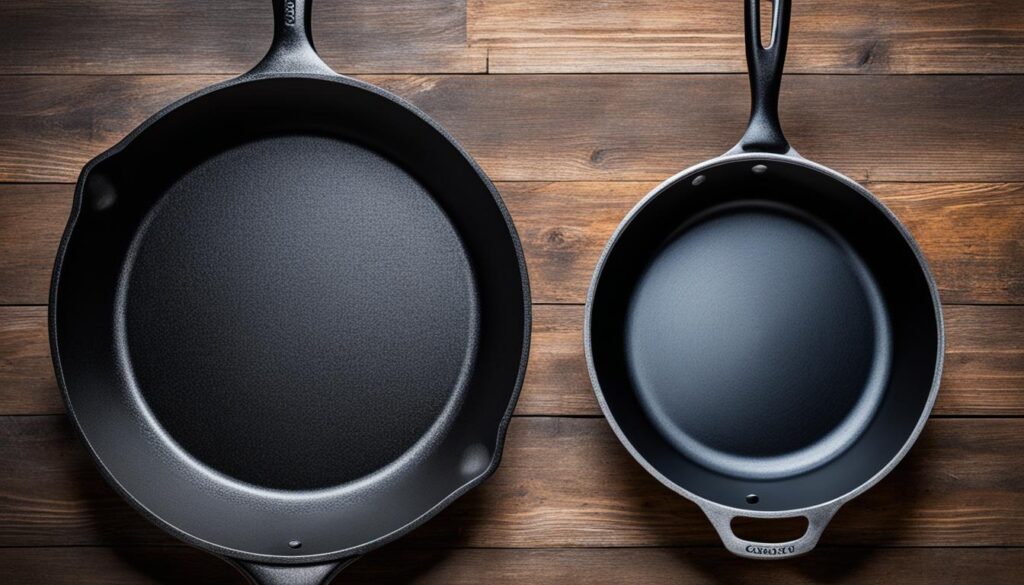
Cast iron pans are very heavy. Their weight helps them keep heat well, but moving them can be hard. Carbon steel, lighter in weight, doesn’t compromise on cooking ability.
Now, let’s look more into the differences in weight:
- Cast iron skillet (10-inch): Usually 5-6 pounds
- Carbon steel pan (10-inch): Typically 3-4 pounds
While the difference might seem small, it’s big when you’re cooking. For example, making a shrimp and broccoli stir fry is easier in the lighter carbon steel pan. You can toss and flip the food more easily.
Let’s see how weight changes cooking tasks:
| Task | Cast Iron | Carbon Steel |
|---|---|---|
| Sautéing | Makes you use more effort | Is simpler to handle |
| One-handed lifting | Is tricky, especially when full | Works for most people |
| Oven transfer | Need to be careful and strong | Is less hard |
| Storage | Requires strong shelves | Fits in almost any spot |
For those who worry about kitchen ergonomics, the carbon steel pan is a winner. Its lower weight eases pressure on wrists and arms. This is great for cooking a lot or for people with physical challenges.
In my view, the decision between cast iron and carbon steel is often personal. I enjoy my cast iron for some meals. But I prefer the carbon steel pan for quicker or longer cooking times.
Versatility in Cooking Applications
Multi-purpose cookware makes cooking more versatile. Cast iron and carbon steel pans are great for many cooking methods. They work well from the stovetop to the oven, improving your meals.
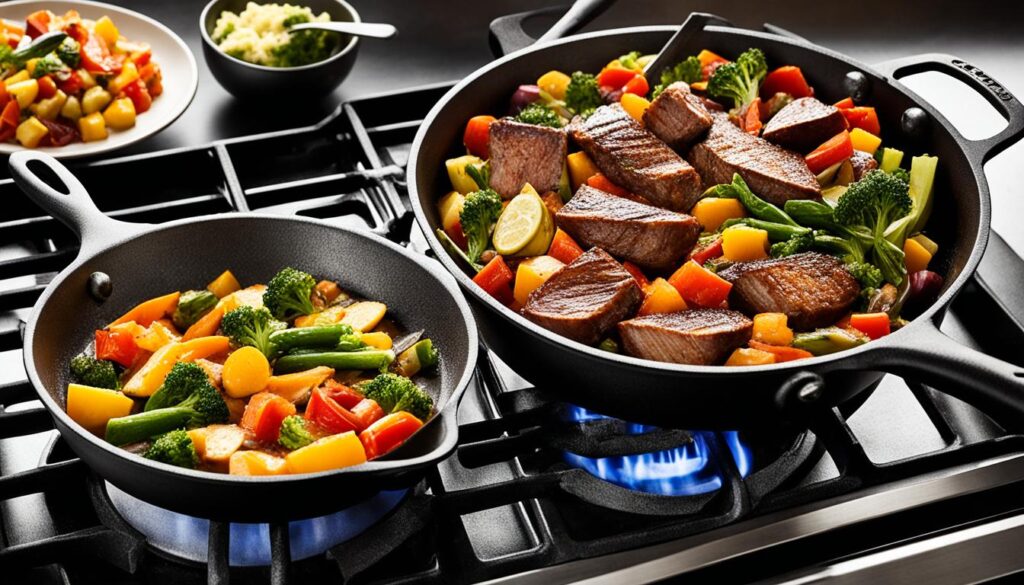
Stovetop to Oven Transition
Cast iron and carbon steel pans go from the stovetop to the oven easily. This lets you cook in many ways. For example, a cast iron skillet can sear a steak and then finish it in the oven. Carbon steel is perfect for starting a frittata and then broiling it.
Searing and High-Heat Cooking
These pans excel at high-heat cooking. Cast iron keeps heat well for steak crusts and crispy fish. Carbon steel heats quickly and evenly for fast stir-fries or cooking scallops just right.
Let’s try a shrimp and dumpling stir-fry recipe to show what these pans can do:
| Ingredient | Amount | Cooking Time |
|---|---|---|
| Medium Shrimp | 1 pound | 2-3 minutes |
| Frozen Vegetable Dumplings | 13 oz package | 3-4 minutes |
| Mixed Vegetables | As desired | 2-3 minutes |
This recipe is quick and feeds 4. It takes 25 minutes to prepare and 30 to cook, perfect for busy nights. The sauce, made with sweet Thai chili sauce, soy sauce, and rice vinegar, is great for dipping or marinating.
Delicate Foods and Low-Heat Cooking
For delicate foods and low heat, carbon steel is better. Its quick temperature changes work well for eggs, thin fish, or French omelettes. Cast iron can do these, but you need to watch the heat carefully.
Choosing between cast iron and carbon steel is tough. Both are versatile and key for many cooking tasks. They are essential in the kitchen for several cooking methods.
Care and Maintenance Requirements
It’s crucial to take good care of your cookware, whether it’s cast iron or carbon steel. I’ll show you how to clean them and stop rust, making them last a long time.
Cleaning Methods
To clean cast iron and carbon steel, be gentle. Here’s what I do after cooking:
- Rinse the pan with warm water
- Use a soft brush or sponge to remove food particles
- For stubborn bits, add coarse salt and scrub gently
- Rinse thoroughly and dry immediately with a clean cloth
I stay away from soap because it can damage the seasoning. For a thorough cleaning, I mix warm water with baking soda.
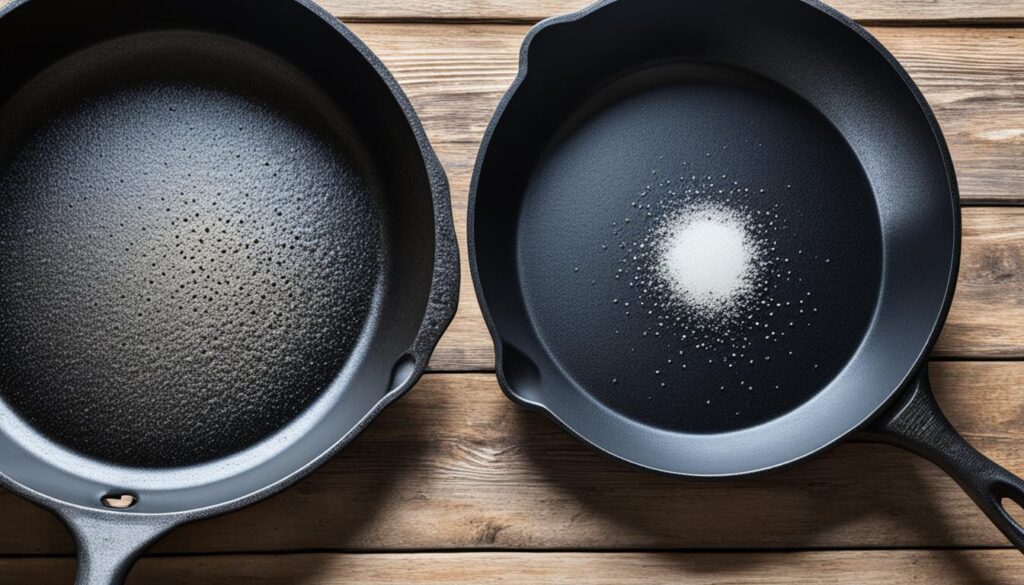
Rust Prevention Techniques
Rust is the last thing you want on your iron pans. I make sure to:
- Dry my pans completely after washing
- Add a thin layer of oil after every use
- Keep them in a dry area with air
- Use a pan liner if stacking them
Following these easy steps helps me keep my pans rust-free and always ready to cook.
Long-term Durability
When you look after cast iron and carbon steel pans well, they can last forever. Here’s how I keep them in top shape:
- Reseason them often, especially after cooking with acids
- Avoid quick temperature changes
- Use gentle utensils like wood or silicone
- Be careful to avoid dropping them
By taking care of my pans in these ways, they get a nice patina. This makes them even better to cook with because food doesn’t stick as much.
| Maintenance Task | Frequency | Benefit |
|---|---|---|
| Clean after use | Every use | Prevents food buildup |
| Apply thin oil layer | After each wash | Maintains seasoning |
| Deep clean | Monthly | Removes stubborn residue |
| Reseason | Every 3-6 months | Restores non-stick surface |
Price Points and Value for Money
Kitchen investment can vary a lot, particularly with cookware like cast iron and carbon steel. Cast iron skillets are often a cheaper option. This makes them great for anyone watching their wallet.
Here’s a quick rundown of some prices:
| Skillet Type | Brand | Size | Price |
|---|---|---|---|
| Cast Iron | Lodge | 10.25-inch | $39.90 |
| Carbon Steel | Merten & Storck | 10-inch | $64 |
| Carbon Steel | OXO Obsidian | 10-inch | $50 |
| Carbon Steel | Smithey Farmhouse | 12-inch | $295 |
Carbon steel skillets are usually priced higher. But they have cool benefits. The Smithey Farmhouse skillet, for example, is handmade and gets better with time.
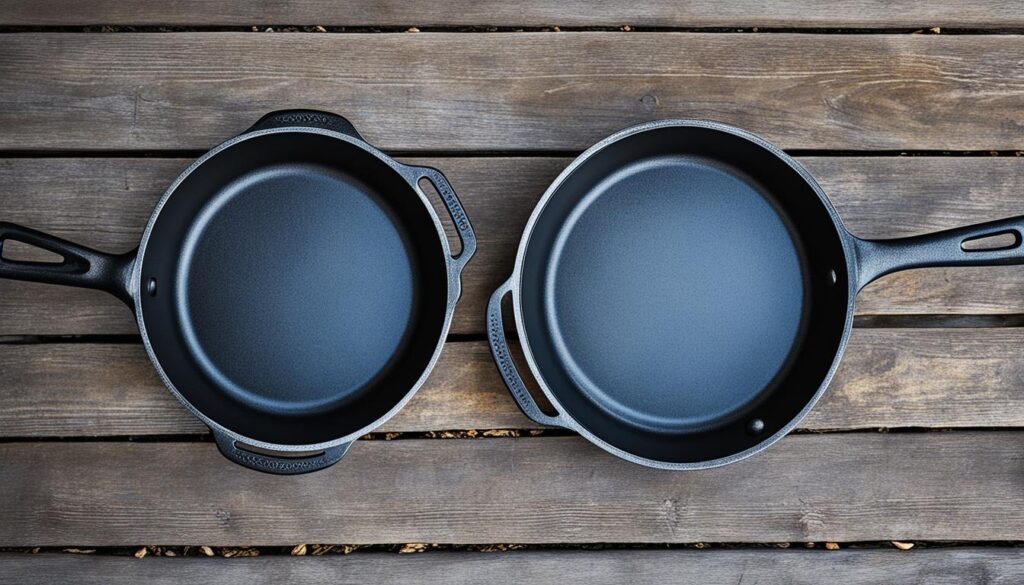
Although carbon steel might cost more at first, it can be a wise kitchen buy. They’re usually lighter than cast iron. This makes them easier to work with. The Merten & Storck 10″ skillet is known for being very light.
Both cast iron and carbon steel last a long time and can do a lot of things in the kitchen. Here’s what you should think about:
- Pre-seasoned vs. DIY seasoning
- Weight and maneuverability
- Heat distribution and retention
- Versatility in cooking applications
Which you choose really depends on how you cook and what you can spend. Whether it’s a basic cast iron or a fancy carbon steel skillet, they’re both great for serious cooks at home.
Making the Final Decision: Which Pan Suits Your Cooking Style?
Choosing between cast iron and carbon steel can be tough. Cast iron is great for keeping heat in. This makes it perfect for making steaks sizzle or baking cornbread to perfection. It’s very durable and can take a lot of heat. That’s why 20% of the fry pan market is cast iron.
But, don’t forget about carbon steel. It’s lighter and heats up fast. This makes it great for quick stir-fries or cooking fish gently. It covers about 15% of the market. If you enjoy flipping your food, you might prefer carbon steel. It comes with sloped sides and is easier to handle.
Think about how you like to cook. If you prefer things easy, both pans will need seasoning. In fact, 40% of fry pans on the market need this extra care. Yet, don’t be put off. With good seasoning, these pans become more non-stick over time. This is unlike Teflon pans, which lose their non-stick features in a year.
In the end, what matters is what works best for you and your cooking style. Whether you pick cast iron’s classic look or go with the chef-loved carbon steel, you’ll be happy. Both types will help you cook wonderful meals for many years.
